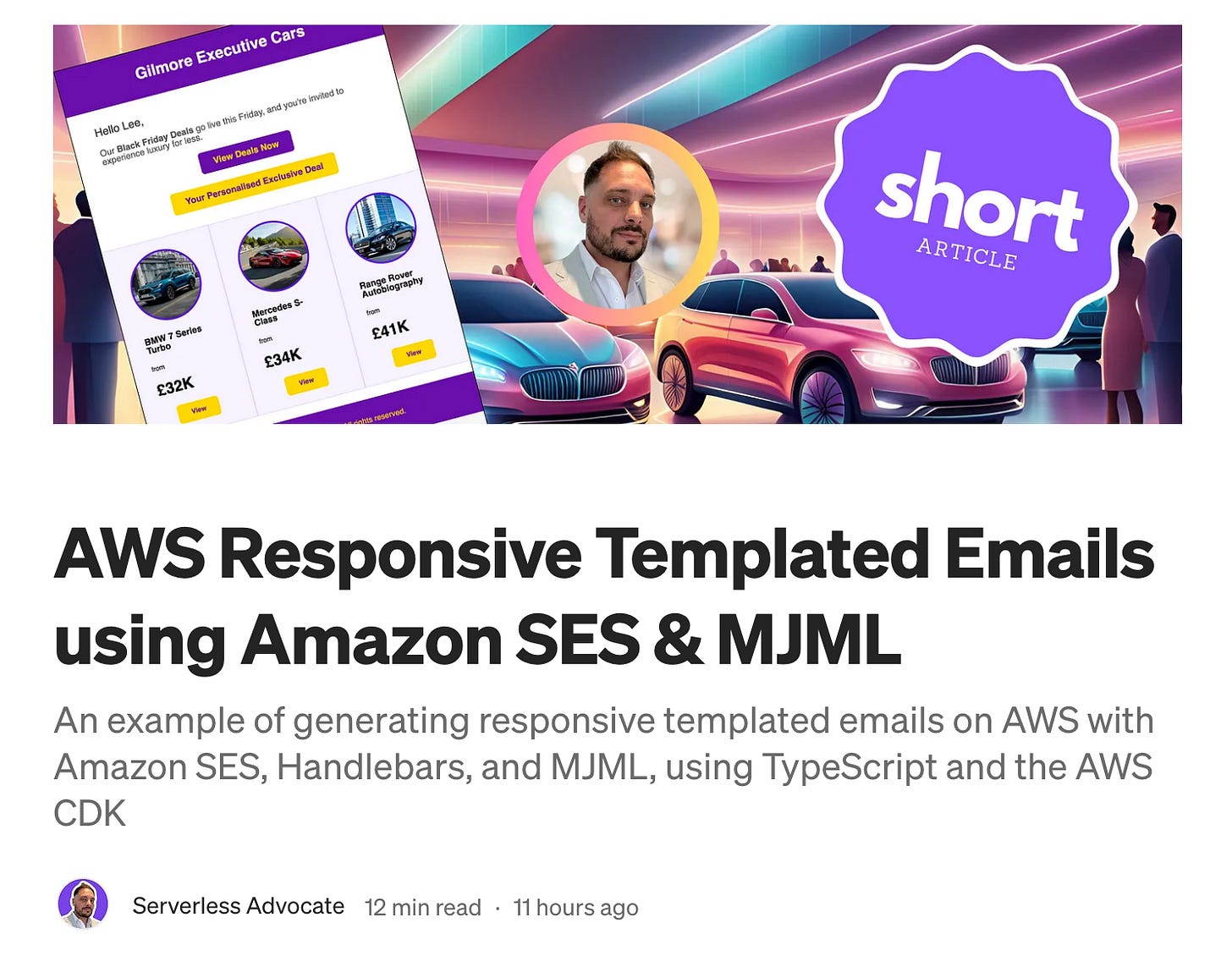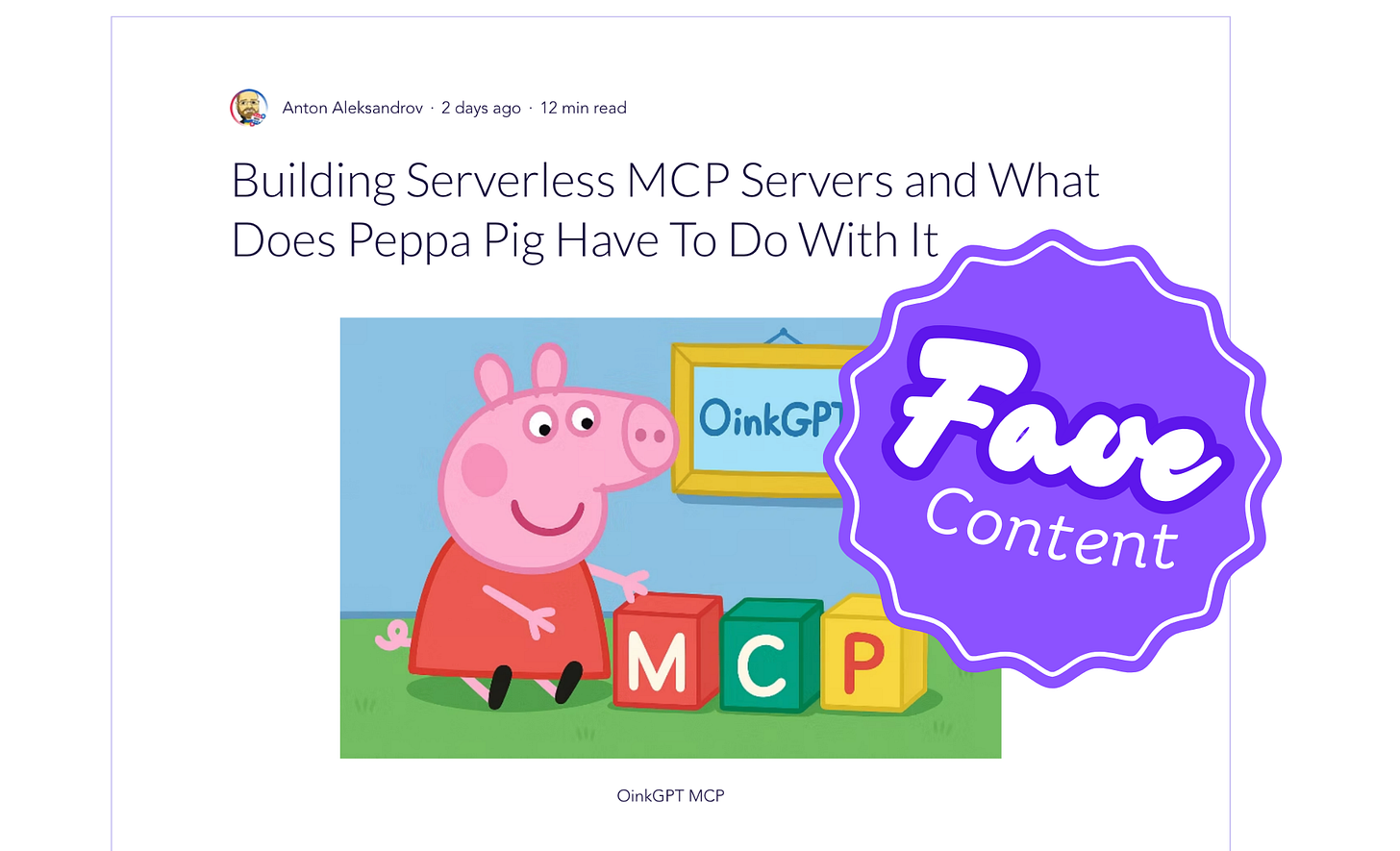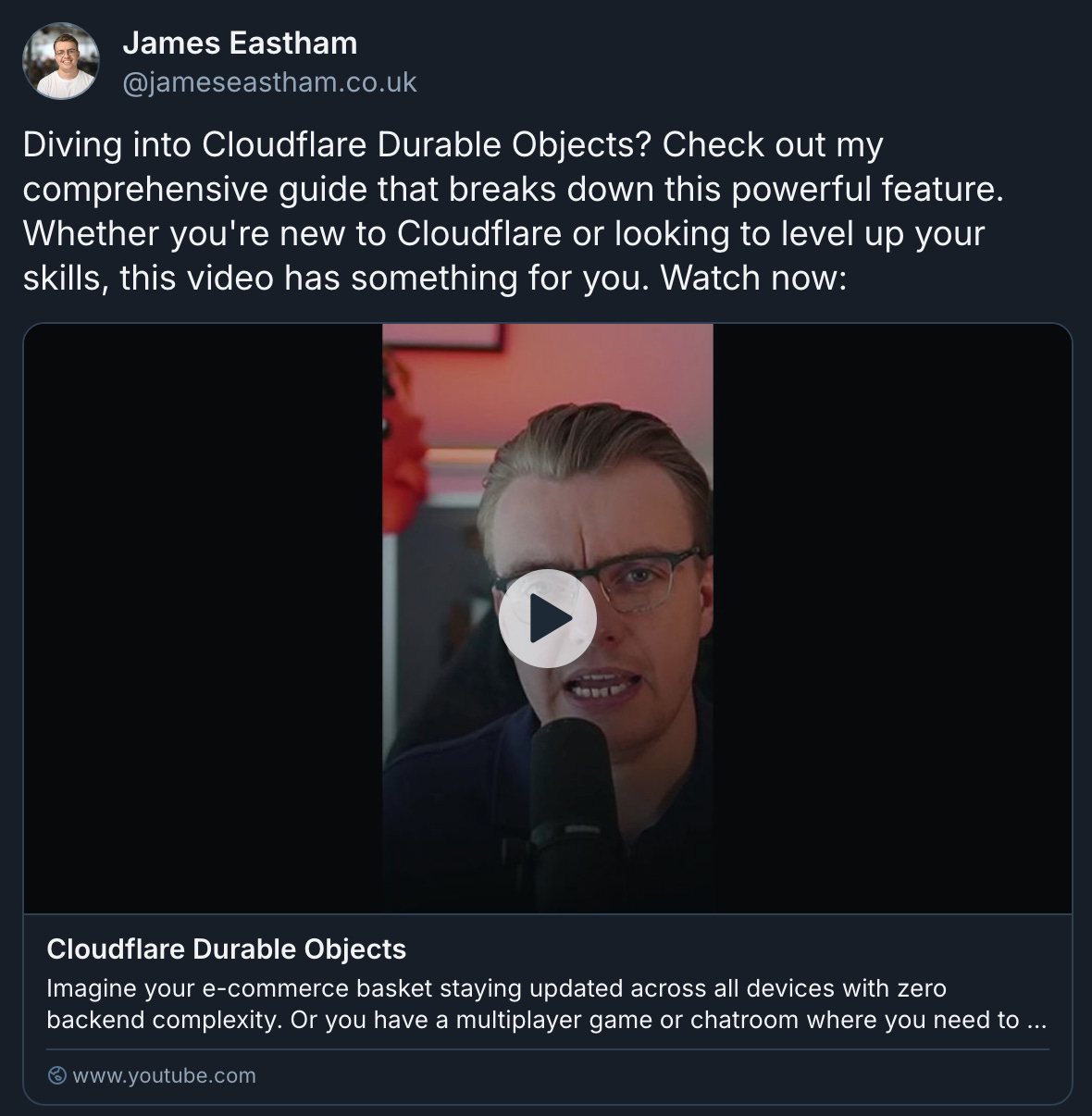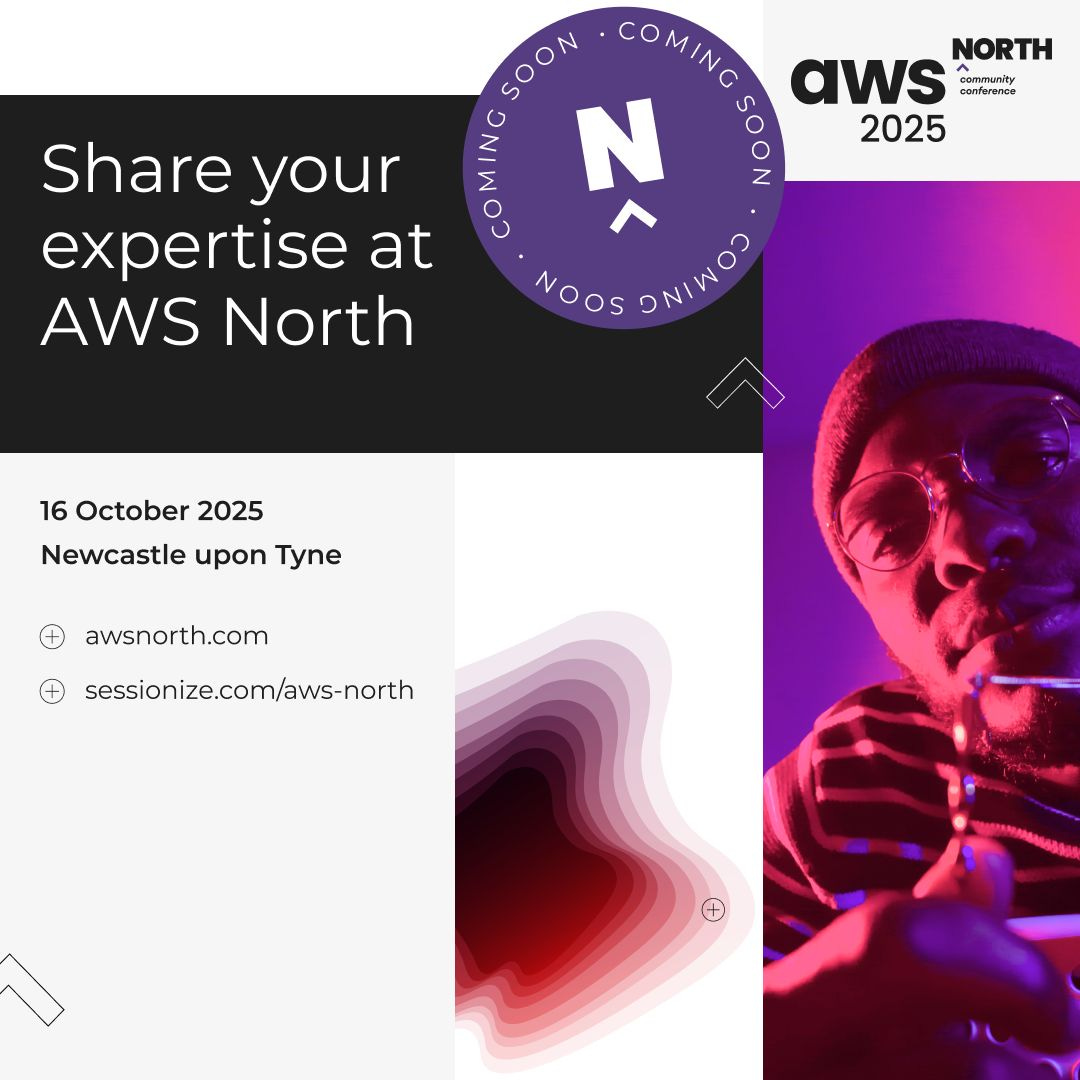#34 MCP everywhere! 🌟
This week, our Serverless expert is AWS Sr. Specialist SA Lee Hannigan, our spotlight falls on AWS Community Builder Marco Troisi, we look at the latest AWS service releases, news, articles, & more!
Welcome
In last week’s issue, our serverless expert was AWS Community Builder David Behroozi, and the spotlight fell on AWS Community Builder Ryan Cormack!
This week, our serverless expert is AWS Sr. Specialist Solutions Architect Lee Hannigan, our spotlight falls on AWS Community Builder Marco Troisi, we look at the latest AWS service releases, blog posts, hints and tips, news and more!
This week’s newsletter is sponsored by Leighton.
A Glimpse into My Week 🎤
This week, I wrote a back to basics article on “AWS Responsive Templated Emails using Amazon SES & MJML“.
I’m still personally a little fatigued on the AI articles and videos right now, so I thought I would continue to run a series of short articles highlighting some of the basic architecture and engineering premises that most AWS practitioners should understand.
Also, I will be at the AWS London Summit next week for anybody who wants to catch up! 👋🏼
📰 Articles that caught the eye
Here are some stand-out articles I read during the week in the World of Serverless!
⭐ My favourite this week was the article by Anton Aleksandrov and Ran Isenberg (and who doesn’t love Peppa Pig too!)
From Serverless Framework to AWS CDK: rebuilding our minimal serverless MCP server by Davide De Sio.
Elias Brange covers how to “Supercharge your Serverless Workflow”.
🎓 Ask the Expert
Each week, I ask a different serverless expert the same three questions to get their personal insights - this week, we have AWS Sr. Specialist Solutions Architect Lee Hannigan:
Opinions are the author’s and do not express the views of their employer.
1. What is one common mistake you see teams making when implementing serverless solutions, and how can they avoid it?
A common pattern we see is teams embracing serverless for its scalability and cost-efficiency, but carrying over assumptions from traditional architectures, particularly when it comes to how data is modelled and accessed on serverless databases such as DynamoDB. One example is designing cloud-native applications with a schema that mirrors a normalised relational model, which can introduce inefficiencies at scale.
To avoid this, start by documenting every read/write operation your application requires (e.g., “fetch a user’s 10 most recent orders” or “look up products by category”). Use composite keys to embed relationships directly into your table structure, such as combining a partition key like USER#123 with a sort key like ORDER#2023-10 to enable efficient, hierarchical queries. Limit Global Secondary Indexes (GSIs) to high-priority access patterns, and treat Scan operations as a red flag, redesign keys or indexes to replace them with targeted Query calls.
With DynamoDB specifically, it’s important to shift the design lens from entities to access patterns. Whether you're working with event-driven pipelines, request/response APIs, or GenAI backends, you need to start by defining how your application will consume data. This naturally leads to more performant and scalable choices across your services, especially for storage.
2. Which serverless tool or service are you most excited about right now, and why?
There’s been a lot of momentum recently across the serverless ecosystem, but one feature that stands out for me is DynamoDB’s warm throughput. It’s a small addition with outsized impact, it allows you to pre-warm read and write capacity ahead of known workload spikes, offering predictable performance for otherwise unpredictable usage patterns.
This is a game-changer for workloads like nightly ML jobs, batch reporting, or flash sales and game launches. In the past, teams might have over-provisioned capacity or built complex smoothing logic. Now, you just set up a one-time pre-warm and your table is ready when the traffic hits.
Another exciting trend is how interconnected the serverless ecosystem is becoming. Services like Step Functions, Lambda, and AppSync continue to deepen their integration with others, such as DynamoDB, EventBridge, and Bedrock, making it easier to compose robust, event-driven architectures with less glue code. These native connections lower the barrier to scale and make it easier to build systems that are both decoupled and deeply capable.
3. What is your favourite trick or tip when working with serverless that the readers may find interesting?
One pattern I often recommend is to embrace constraints as a design advantage. Serverless architectures encourage statelessness, minimal permissions, and short execution times, these aren't just limitations; they’re signals. Leaning into them forces simplicity, and simplicity scales.
Take DynamoDB, for example, a lesser-known technique is using conditional writes to handle lightweight business logic. It allows your system to make atomic decisions without relying on extra compute cycles, like checking for duplicates, enforcing idempotency, or coordinating across distributed components.
The more you can express intent directly within the platform, whether it's in storage, messaging, or orchestration, the more efficient and reliable your serverless architecture becomes. These patterns don’t just reduce code, they reduce operational surprises.
✅ Bonus tip: join the hashtag#believeinsls discord! There is a community there to answer any questions you may have without getting overzealous on serverless or without judgment! Check it out!
🚀 New Releases
Here are the latest and most interesting releases this week in the AWS World:
⭐ This week, my favourite update is Prompt Optimisation in Amazon Bedrock, and the AppSync Events data source integrations!
AWS AppSync Events now supports data source integrations for channel namespaces.
Enhance real-time applications with AWS AppSync Events data source integrations.
AWS AppConfig now supports Internet Protocol Version 6 (IPv6).
Amazon Redshift adds history mode support to 8 third-party SaaS applications.
Prompt Optimization in Amazon Bedrock now generally available.
Announcing Serverless Reservations, a new discounted pricing option for Amazon Redshift Serverless.
Amazon Bedrock Intelligent Prompt Routing is now generally available.
Amazon RDS Proxy is now available in 3 additional AWS regions.
Amazon Kinesis Data Streams increases default shard limits to up to 20,000 per AWS account.
Customer Carbon Footprint Tool has new features and an updated methodology.
🔥 Tip: Check out https://aws-news.com/ for the very latest up-to-date serverless releases as they happen, created by the talented AWS Serverless Hero Luc van Donkersgoed.
👷🏻 Tools & Frameworks
Check out the latest open-source frameworks, news, and tool updates from the past week.
Lambda PowerTools v2.19.0 - A new integration has been released for Event Handler to work with AWS AppSync Events APIs. This utility provides a structured way to handle AppSync real-time events through dedicated handler methods, automatic routing, and flexible configuration options.
Lambda-MCP-Server - This project demonstrates a powerful and developer-friendly way to create serverless MCP (Model Context Protocol) tools using AWS Lambda.
powertools-mcp - A Model Context Protocol (MCP) server that provides search functionality for AWS Lambda Powertools documentation across multiple runtimes.
kye (Know Your Enemies) - This tool analyzes IAM Role trust policies and S3 bucket policies in your AWS account to identify third-party vendors with access to your resources. It compares the AWS account IDs found in these policies against a reference list of known AWS accounts from fwd:cloudsec to identify the vendors behind these accounts.
💡 DynamoDB Tip of the Week
Each week we have a quick DynamoDB tip from our resident DynamoDB expert, Uriel Bitton.
💡 Use IA tables when storage costs > 50% of total costs
If more than half of your DynamoDB cost comes from storage, consider using infrequently accessed (IA) tables. They offer cheaper storage costs, ideal for archival or rarely-read data.
https://aws.amazon.com/dynamodb/standard-ia/
✖️ Social of the Week
This week’s social is on BlueSky by James Eastham:
I still haven’t had a chance to play around with CloudFlare Durable Objects, but it is now on my list for the weekend’s play and learning time! What are your experiences in using them? Are you using them in production? Leave a comment below!
🎙️ YouTube & Podcasts
Here are some of my favourite videos and podcasts this week.
⭐ My favourite video this week is more great MCP work from Allen and Andres!
“So you have an MCP server...now what?” with Allen Helton and Andres Moreno.
Standout BAD HABITS Even Senior Programmers Have with Dave Farley.
“Is Vibe Coding a Fad? Vibe Coding my Personal Website” with Erik Hanchett.
Charles Humble & Trisha Gee cover “Professional Skills for Software Engineers”.
The Impossible Journey Part 2 ft. with Rajdeep Saha and Luca Mezzalira.
“The #1 Pattern You Need To Know When Publishing Events” with James Eastham.
Weekly Case Study 🔍
This week’s case study comes from the Universe Group which uses Amazon SageMaker to power AI-driven photo and video editing.
Universe Group used Amazon SageMaker to scale Visify, its AI-powered photo and video editing app, to support 900,000 users across 180 countries; achieving 82.5% faster image processing and 75% faster video generation while handling up to 3.5 TB of GPU memory at peak.
By deploying 250 ML endpoints and leveraging JupyterLab and custom Docker images, the team was able to iterate rapidly and support advanced features like photorealistic avatars and age progression. The move to AWS not only improved scalability and performance but also streamlined R&D and lowered operational overhead, setting the stage for future AI features with minimal friction.
🗣️ Inspirational Quotes and Thoughts
This week’s inspirational quote comes from AWS Community Builder and DataDog Developer Advocate, James Eastham.
“An event driven architecture lets you tell the story of your business, through it’s technical implementation”
― James Eastham
I love this quote from James, as it hits the nail on the head in a simple but powerful way - any business runs on events which are typically immutable, documented, traceable and factual, and that is a powerful paradigm that let’s you understand exactly how your business runs both day to day, and over time. EDA is like writing a live story of your business, where each event becomes a meaningful chapter.
🗳️ Poll of the Week
In last week’s poll, we asked the question “When streaming data from DynamoDB to a more flexible or analytics-friendly destination, which AWS service or pattern do you typically use?“.
Interestingly, 71% said they use Amazon OpenSearch Serverless, with 14% going to Algolia and MongoDB/DocumentDB. I don’t think I am overly surprised by this, as in the past my go-to has been OpenSearch, otherwise I would have probably used document storage for the overall solution (like MongoDB Atlas).
This week, we ask the question, “Do you use internal private Amazon API Gateways in your solutions?”. Do you use microservices where internal services use private API gateways, or do you traverse the public network between services that are considered internal? What are the tradeoffs you see with private Amazon API Gateways?
Feel free to leave a comment below on why you chose your answer and your experiences!
📅 Serverless Events
The following serverless events are upcoming, so mark your calendars.
🎟️ To note, CFP is currently open for the AWS North Community Conference which I am helping organise, and we also have opportunities for lightening talks throughout the day. Go check it out!
Other fantastic events happening soon:
AWS Community Day CZ - 29th April 2025
ServerlessDays Belfast 2025 - 15th May 2025
ACD Bengaluru - 23rd May 2025
ACD Adria - 5th Sept 2025
AWS Community Day Baltic - 10th Sept 2025
ACD DACH - 7th Oct 2025
AWS North Community Conference - 16th Oct 2025
Do you have any upcoming events that you want to highlight? Message me below!
⭐ Spotlight
This week’s spotlight falls on AWS Community Builder Marco Troisi!
Marco is the owner of the fantastic Serverless Mindset Newsletter, Serverless Mindset Podcast, blogger, speaker, AWS Community Builder, CTO, and more, based in the UK. Thank you for all you do for our wonderful Serverless community!
Thank you for reading the latest Serverless Advocate Newsletter!
If you want to find out a little more about me, please have a look at:
https://www.serverlessadvocate.com/
See you next time,
Lee














